Our Catch
Over the course of a year, our guests have the opportunity to catch many different species of fish. Quite a few of them are listed below. The time of year we are most likely to catch each species is included at the end of it's description.
- Atlantic Croaker (hardheads)
- Atlantic Spadefish
- Black Drum
- Blue Crab
- Bluefish
- Cobia
- grey Trout (weakfish)
- Norfolk Spot
- Pigfish
- Red Drum (redfish)
- Sea Mullet (southern kingfish, roundheads)
- Shark (various species)
- Sheepshead
- Spanish Mackerel
- Silver Perch (sand perch)
- Speckled Trout (spotted sea trout)
- Striped Bass (striper, rockfish)
- Summer Flounder
- Tautog
Atlantic Croaker (hardheads)
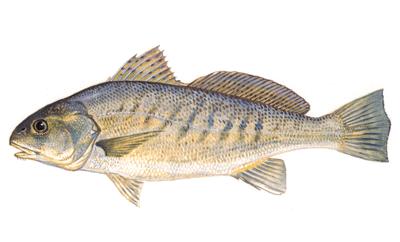 Croaker get their name from the "croaking" noise the make when removed from the water. Croaker are one of the smaller members of the Drum family. They are hard fighters and great table fare. We bottom fish for hardheads, usually with the boat on a drift.
Croaker get their name from the "croaking" noise the make when removed from the water. Croaker are one of the smaller members of the Drum family. They are hard fighters and great table fare. We bottom fish for hardheads, usually with the boat on a drift.
Description: silvery color overall with a white belly; often has a faint bronze or golden cast, with yellowish fins; back often has small brassy spots, that align into wavy lines down the fish’s sides; underslung jaw features 3 to 5 pairs of barbels under the chin; caudal fin is convex in shape; gill cover is hard and sharp.
- Season: March - October
- Capture Citation: 3 Lbs
- Release Citation: 20 IN.
- State Record: 8 lbs 11 oz, 2007, Norman T. Jenkins
Atlantic Spadefish
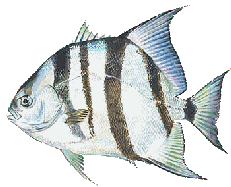 Atlantic Spadefish are amazingly strong fighters and great to eat! We fish for "spades" around wrecks, towers, artificial reefs and other structure.
Atlantic Spadefish are amazingly strong fighters and great to eat! We fish for "spades" around wrecks, towers, artificial reefs and other structure.
Description: Spadefish have very deep, compressed, disk-shaped bodies and a blunt snout. The second dorsal and anal fins of adults have long, trailing anterior lobes, giving an "angelfish-like" appearance. The body is silver in color with irregular black vertical bands that fade gradually with age.
- Season: June - September
- Minimum Size Limit: None
- Possession Limit: 4 per person
- Capture Citation: 9 Lbs
- Release Citation: 22 IN.
- State Record: 14 lbs 14 oz, 2009, Roland E. Murphy
Black Drum
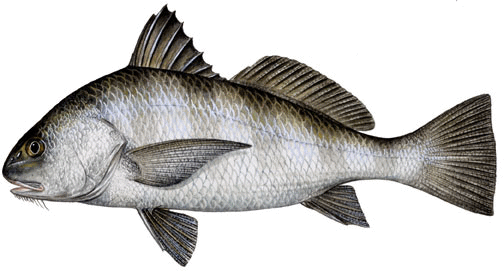 Black Drum are one of the larger members of their family. Usually caught bottom fishing or slow jigging around structure.
Black Drum are one of the larger members of their family. Usually caught bottom fishing or slow jigging around structure.
Description: bronze, copper or greyish back, fading to a light colored belly; occassionally has a more silvery appearance; color fades after death to a greyish or greyish-green hue; high arched back gives most fish a “humpback” shape; 10 to 14 pairs of barbels are prominent under chin; caudal fin is square and pectoral fin comes to a pronounced point; juvenile fish (generally under 15 pounds) display 4 to 6 dark vertical bars, which fade in adults.
- Season: April - September
- Minimum Size Limit: 16 IN.
- Possession Limit: 1 per person
- Capture Citation: 80 Lbs
- Release Citation: 46 IN.
- State Record: 111 lbs, 1973, Betty D. Hall
Blue Crab
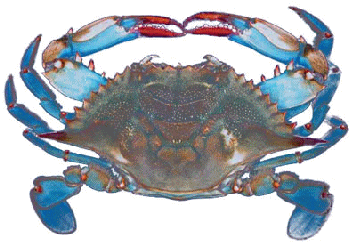 We catch Chesapeake Bay Blue Crabs several different ways. We utilize a commercial style "pot", hand lines, and drop traps. Crabbing is not only the most valuable fishery in the Chesapeake Bay, but Blue Crabs are major predators of many organisms that live in and on the bottom of the Bay floor, and are prey for many other fish species.
We catch Chesapeake Bay Blue Crabs several different ways. We utilize a commercial style "pot", hand lines, and drop traps. Crabbing is not only the most valuable fishery in the Chesapeake Bay, but Blue Crabs are major predators of many organisms that live in and on the bottom of the Bay floor, and are prey for many other fish species.
Description: Blue crabs are sexually dimorphic, meaning sexes occur in distinct forms. Males have blue claws and a narrow abdominal apron (referred to as the Washington Monument). Mature females have red-tipped claws ("painted fingernails") and a broad abdominal apron (referred to as the Capitol dome).
Size: Minimum legal size for Jimmies (males) is 5 inches point-to-point.
Season: May - September
Bluefish
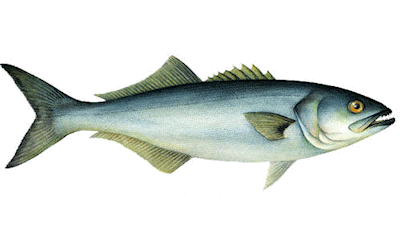 Blues are usually caught trolling Clark spoons. Larger bluefish are sometimes landed when we are live baiting for other large predators. Bluefish is excellent smoked.
Blues are usually caught trolling Clark spoons. Larger bluefish are sometimes landed when we are live baiting for other large predators. Bluefish is excellent smoked.
Description: long body is bluish green in coloration, fading to a light colored belly; tail is sharply forked and the mouth features razor sharp teeth.
- Season: May - October
- Minimum Size Limit: None
- Possession Limit: 10 per person
- Capture Citation: 16 Lbs
- Release Citation: 36 IN.
- State Record: 25 lbs 4 oz, 1986, Gayle E. Cozzens
Cobia
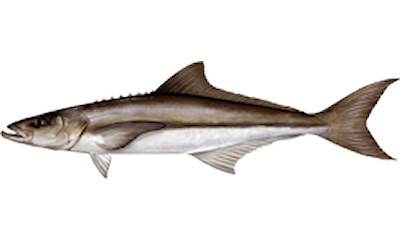 Cobia are one of the largest fish that we catch. We stalk them by sight casting around structure. We also live bait for them in a chum slick behind the boat while anchored.
Cobia are one of the largest fish that we catch. We stalk them by sight casting around structure. We also live bait for them in a chum slick behind the boat while anchored.
Description: large, long fish which is dark, chocolate brown on the back and sides fading to a white belly; juveniles often display a brown back with a white horizontal stripe, a very dark stripe and a second white stripe down the sides; the tail is deeply forked and the first dorsal fin is absent (replaced by 7 to 9 short spines) but they feature a pronounced second dorsal fin; the lower jaw protrudes past the upper jaw.
- Season: June - September
- Minimum Size Limit: 37 IN.
- Possession Limit: 1 per person
- Capture Citation: 55 Lbs
- Release Citation: 50 IN.
- State Record: 109 lbs, 2006, Joseph F. Berberich, II
Grey Trout (weakfish)
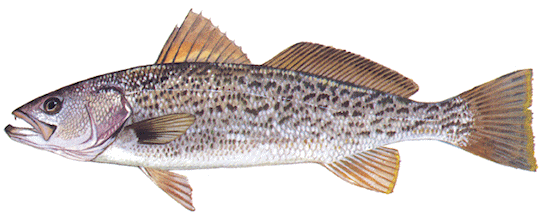 Grey trout are highly sought after, but getting more and more difficult to find. We jig and fish with cut bait for greys.
Grey trout are highly sought after, but getting more and more difficult to find. We jig and fish with cut bait for greys.
Description: silvery body and sides with some olive shading along the top of the back; numerous dark blotches appear on the back and the sides, some of which may appear to align and form wavy lines; fins are a uniform dusky color, some of which may have a yellowish margin; body is long and slender; upper jaw possesses two large canine teeth.
- Season: April - October
- Minimum Size Limit: 12 IN.
- Possession Limit: 1 per person
- Capture Citation: 9 Lbs
- Release Citation: 30 IN.
- State Record: 19 lbs, 1983, Philip W. Halstead
Norfolk Spot
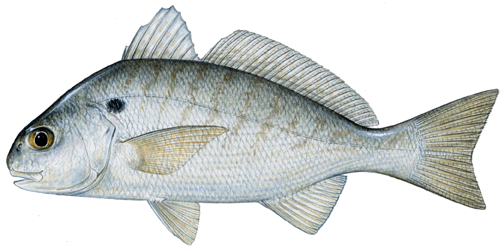 These small members of the drum family are so named because of the prominent black spot that appears behind their gill flap. Although Norfolk spot rarely exceed 10 inches in length, they make excellent table fare. Spot are excellent live bait for striped bass, bluefish, trout, red drum, cobia, sharks, and other gamefish. To catch spot we usually bottom fish while drifting, just as we do for croaker.
These small members of the drum family are so named because of the prominent black spot that appears behind their gill flap. Although Norfolk spot rarely exceed 10 inches in length, they make excellent table fare. Spot are excellent live bait for striped bass, bluefish, trout, red drum, cobia, sharks, and other gamefish. To catch spot we usually bottom fish while drifting, just as we do for croaker.
Description: silvery color overall with a white belly; a prominent black spot is present behind the gill cover and above the base of the pectoral fin; several wavy lines, brassy in color, extend down the back; caudal fin is slightly concave; larger individuals in the late summer often exhibit a distinct yellow coloration on their bellies.
- Season: June - October
- Capture Citation: 1 Lbs
- Release Citation: 13 IN.
- State Record: 2 lbs 6 oz, 1980, Nathan Dryden
Pigfish (hogfish)
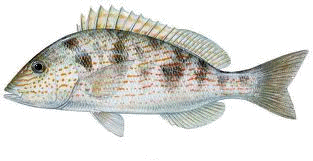 Pigfish are usually small, but are quite tasty and sought after as a pan fish.
Pigfish are usually small, but are quite tasty and sought after as a pan fish.
Description: coloration is greyish along the back fading to silver along the sides and a silvery white belly; brassy to bronze mottled marks are scattered over much of the body; fins tend to be a dull golden color; the first dorsal fin has distinct spines; the name derives from the grunting noise these fish make when removed from the water.
Size: up to 2 pounds; average size is ½ – 1 pound.
Season: June - October
Red Drum (redfish, channel bass, puppy drum)
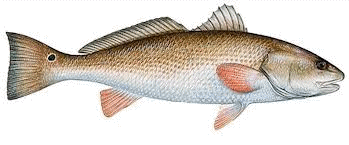 Red drum are one of the largest members of the Drum family. Large adults can weigh over 50 pounds. We fish for these giants with cut and live baits. In smaller tributaries feeding the Bay, juvenile redfish that we call "puppy drum", sometimes congregate in large numbers. We fish for these smaller reds in the same manner as we do speckled trout; light tackle and lures.
Red drum are one of the largest members of the Drum family. Large adults can weigh over 50 pounds. We fish for these giants with cut and live baits. In smaller tributaries feeding the Bay, juvenile redfish that we call "puppy drum", sometimes congregate in large numbers. We fish for these smaller reds in the same manner as we do speckled trout; light tackle and lures.
Description: copper to bronze colored back, fading to a white belly; may be more silvery in appearance in clear or ocean waters; one to several ocellated spots occur at the base of the tail; caudal fin is slightly lunate and pectoral fin is rounded; large scales and underslung jaw.
- Season: April - November
- Minimum Size Limit: Min 18 IN. to Max 26 IN.
- Possession Limit: 3 per person
- Capture Citation: RELEASE ONLY
- Release Citation: 46 IN.
- State Record: 85 lbs 4 oz, 1981, Herman Moore
Sea Mullet (southern kingfish, roundheads)
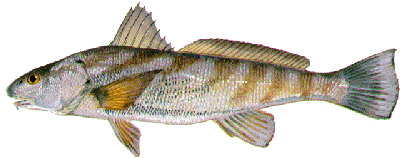 Roundheads have excellent flavor and are highly sought after as pan fish.
Roundheads have excellent flavor and are highly sought after as pan fish.
Description: long, slender body is greyish-silver on the sides; 6 to 8 very faint dusky bars may be present along the back and sides; fins are dusky in color; underslung mouth features a single barbel under the chin.
- Season: June - October
- Capture Citation: 1 Lb 8 oz
- Release Citation: 16 IN.
- State Record: 2 lbs 13 oz, 2002, Chip Watters
Shark (various species)
 On charters with us in years past, sharks were considered a "nuisance" while fishing for cobia and other larger fish. Today we find that many guests enjoy targeting these top tier predators on "catch, photo and release" trips.
On charters with us in years past, sharks were considered a "nuisance" while fishing for cobia and other larger fish. Today we find that many guests enjoy targeting these top tier predators on "catch, photo and release" trips.
- Season: June - September
- Capture Citation: RELEASE ONLY
- Release Citation: 72 IN.
Sheepshead
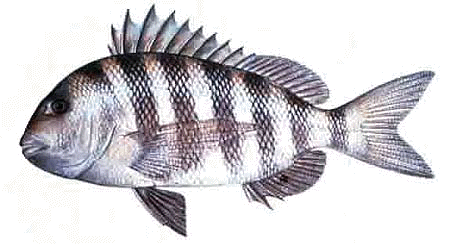 Sheepshead are part of the grunt family. Sheepshead can be very tricky to catch, due to their feeding habits and ability to evade hooks. We fish for them with light tackle, light leaders, small hooks and cut bait.
Sheepshead are part of the grunt family. Sheepshead can be very tricky to catch, due to their feeding habits and ability to evade hooks. We fish for them with light tackle, light leaders, small hooks and cut bait.
Description: a deep bodied fish that is greyish in color along the back and sides with a belly that is only slightly lighter in color; 5 to 6 black (or very dark brown) bars run down the sides; mouth is filled with formidable incisor and molar teeth; pectoral fin is long and pointed.
- Season: May - October
- Minimum Size Limit: None
- Possession Limit: 4 per person
- Capture Citation: 10 Lbs
- Release Citation: 24 IN.
- State Record: 20 lbs 12 oz, 2005, Arun Nhek
Silver Perch (sand perch)
 Description: small member of the drum family with bright silvery coloration fading to a white belly; fish from estuarine waters that are not clear may have a slightly darkish coloration along the top of the back; easily distinguishable from other members of the drum family by lack of chin barbels and mouth that is not underslung.
Description: small member of the drum family with bright silvery coloration fading to a white belly; fish from estuarine waters that are not clear may have a slightly darkish coloration along the top of the back; easily distinguishable from other members of the drum family by lack of chin barbels and mouth that is not underslung.
Size: under 1 pound; average size ranges from 4 – 7 inches
Season: May - October
Spanish Mackerel
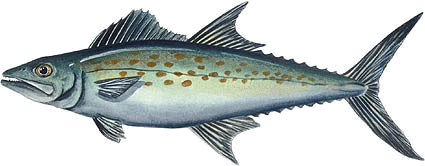 We normally troll Clark spoons on diving planers for Spaniards. A crew that is willing to get an early morning start can load up in a hurry! (Hint ;-)
We normally troll Clark spoons on diving planers for Spaniards. A crew that is willing to get an early morning start can load up in a hurry! (Hint ;-)
Description: a slender fish with a deeply forked tail, caudal peduncle keel, and a mouthful of sharp teeth; coloration is green or greenish blue on top fading to silver sides and belly; a large number of irregular bright golden spots adorn the sides; front portion of first dorsal fin is jet black in color.
- Season: May - October
- Minimum Size Limit: 14 IN.
- Possession Limit: 15 per person
- Capture Citation: 4 Lbs
- Release Citation: 26 IN.
- State Record: 9 lbs 13 oz, 1993, Everett Cameron
Speckled Trout (spotted sea trout)
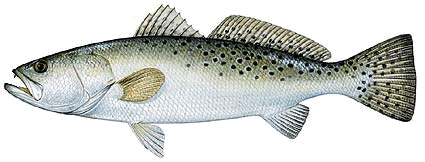 Our customers seem to most enjoy fishing for "specks" with artificial lures on light tackle. We cast small jigs, soft plastics, and hard lures around the edges of grass beds, points, creek mouths, oyster beds, and other areas.
Our customers seem to most enjoy fishing for "specks" with artificial lures on light tackle. We cast small jigs, soft plastics, and hard lures around the edges of grass beds, points, creek mouths, oyster beds, and other areas.
Description: greyish silver back (often with a bluish, iridescent tint) fading to silver sides with a white belly; distinct round black dots are present on back and sides, and they extend onto second part of the dorsal fin and the caudal fin; body is long and slender; upper jaw possesses two large canine teeth.
- Season: April - October
- Minimum Size Limit: 14 IN.
- Possession Limit: 5 per person, only 1 greater than 24"
- Capture Citation: 5 Lbs
- Release Citation: 24 IN.
- State Record: 16 lbs, 1977, Bill Katko
Striped Bass (striper, rockfish)
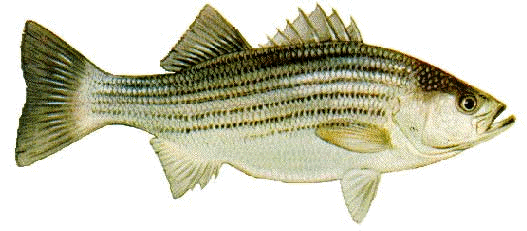 Rockfish are one of our most sought after species. We fish for stripers by trolling, jigging, chumming, live baiting, and casting artificial lures.
Rockfish are one of our most sought after species. We fish for stripers by trolling, jigging, chumming, live baiting, and casting artificial lures.
Description: overall coloration is silvery with a white belly; back tends to be a dark, olive or dusky brownish color; 7 or 8 pronounced black stripes run horizontally down the back and sides of the fish; the spines in the first dorsal fin are stiff and the gill cover is hard and sharp.
After an exciting day of Chesapeake Bay Striped Bass fishing, have you ever been curious as to how old that rockfish was you caught? If you know how long your striper was, you can approximate the weight and age of your catch by using our Striper Weight/Age chart!
- Season: October 4 - March 31, May 1 through June 15
- Size and possession limits vary by season
- Capture Citation: 40 Lbs
- Release Citation: 44 IN.
- State Record: 74 lbs, 2012, Cary Wolfe
Summer Flounder (fluke, flatfish)
 Flounder are one of the most prized fish in our waters. They are great to eat and are fun to catch.
Flounder are one of the most prized fish in our waters. They are great to eat and are fun to catch.
Description: rounded, flat body is brown on one side (the left side) and white on the other side; both eyes appear on the brown (left) side of the fish; caudal fin is convex and the mouth features sharp, cone-like teeth; summer flounder feature five ocellated spots on their brown side, three tending to form a triangle just above the base of the tail.
- Season: March - October
- Minimum Size Limit: 16 IN.
- Possession Limit: 4 per person
- Capture Citation: 7 Lbs
- Release Citation: 26 IN.
- State Record: 17 lbs 8 oz, 1971, Charles E. Cross
Tautog (blackfish)
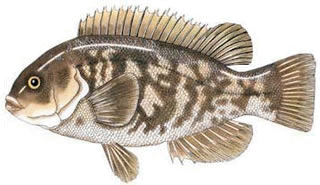 We fish area wrecks for these delicious fish. Description: a thick-bodied fish characterized by thick lips, blunt snout, and large, irregular teeth (incisors in front, molars in the rear); coloration is varied from a chocolate brown, to grey or a blackish olive on the back and sides with a white belly; some fish have irregular blotches on the side, but this mottling pattern, often associated with spawning activity, is not present in all individuals; males have a more blunt head, a more pronounced white chin, and a distinct white spot on their side.
We fish area wrecks for these delicious fish. Description: a thick-bodied fish characterized by thick lips, blunt snout, and large, irregular teeth (incisors in front, molars in the rear); coloration is varied from a chocolate brown, to grey or a blackish olive on the back and sides with a white belly; some fish have irregular blotches on the side, but this mottling pattern, often associated with spawning activity, is not present in all individuals; males have a more blunt head, a more pronounced white chin, and a distinct white spot on their side.
- Minimum Size Limit: 16 IN.
- Possession Limit: 3 per person
- Season: Closed Season: May 1 - Sept 19
- Capture Citation: 9 Lbs
- Release Citation: 23 IN.
- State Record: 24 lbs 3 oz, 2012, Ken Neill, III